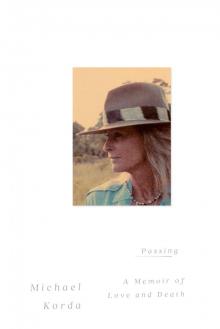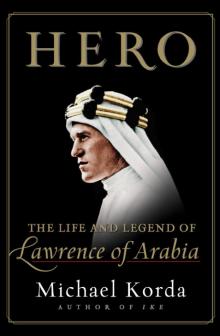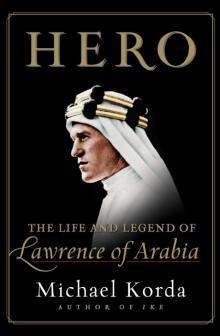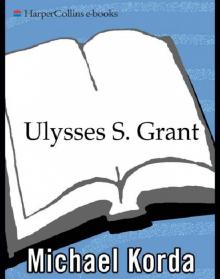- Home
- Michael Korda
Hero Page 4
Hero Read online
Page 4
Perhaps in deference to the fact that he was an Englishman, not an Arab, his guides called a halt at midnight, and allowed Lawrence a few hours of sleep in a hollow in the sand, then woke him before dawn to continue, the road now climbing the length of a great field of lava, againstwhich pilgrims for untold generations had left cairns of rocks on their way south, then across a wide area of “loose stone,” then on and upward until at last they reached the first well of their journey. They were now in territory controlled by the local tribes, who favored the Turks, or whose sheikhs received payment from the Turks, and reported on the movement of strangers.
No well on a much-used route like this one was ever likely to be deserted—a well was the Arab equivalent of a New England village store—and with good reason Ali had warned Lawrence strictly against talking to anyone he might meet along the way. Neither then nor later did Lawrence ever try to pass himself off as a native—his Arabic was adequate, but in each area of the Ottoman Empire, and beyond, it was spoken differently, and both his speech and his appearance marked him out as a stranger—not necessarily an Englishman, because his fair coloring and straight, sharp nose were not uncommon among Circassians, but certainly not a Bedouin.
Anything but a lush oasis, the well was a desolate place, surrounded by the remains of a stone hut, some rude “shelters of branches and palm leaves,” and a few shabby, ragged tents. A small number of Bedouin watched after their camels from a distance as Obeid’s son Abdullah climbed down into the well and brought up water in a goatskin, while his father and Lawrence rested in the shade.
Lawrence seems to have attracted no attention, even when a group of Harb tribesmen driving a large herd of camels arrived, followed, perhaps more dangerously, by two richly dressed young men riding thoroughbred camels: a sharif and his cousin disguised as a master and servant to pass through the country of a hostile tribe undisturbed. This pair might at least have been expected to express some curiosity about the presence of a stranger at the well, but Lawrence seems to have possessed a natural gift for remaining silent and motionless, without betraying himself—he had always been fearless; from boyhood on he had deliberately cultivated indifference to danger and hardship, as well as emotional independence, as if rehearsing for the role he was about to play, and his lack of fearsomehow communicated itself to others in the sense that they felt he belonged where he was, whoever he might be.
In some ways, this was more effective than a vulgar disguise—the real Lawrence was actually less noticeable than if he had tried to darken his skin and pretend to be an Arab, like Sandy Arbuthnot, a character in John Buchan’s classic adventure novel Greenmantle, who many believe was based in part on Lawrence. It was something of a skill, the equivalent of camouflage or protective coloration. As a junior staff officer Lawrence had sat unnoticed among vastly more senior officers in meetings where he had no business to be, without attracting attention to his presence until he spoke (at which point, he usually dominated the conversation); he did the same among the Bedouin. His individualism—and later his curious combination of fame and shyness—gave people the impression that he never “belonged” anywhere, but he had the great actor’s gift for playing whatever role was presented to him. It was then not yet apparent that the role of a hero would come to him more easily—and stick to him much longer—than any other.
In any case, unquestioned, Lawrence and his guides continued on through an increasingly difficult and barren landscape, which gradually gave way to fine white sand that radiated the heat and the glare of the sun until he had to close his eyes against it. In the distance were fantastic rock formations and jagged mountains. They had left the roadway, such as it was, to track across country for hours, and rejoined it just as the sun began to set. Bir el Sheikh, when they reached it, proved to be nothing more than a tiny cluster of “miserable” rock huts on either side of the way, from which the smoke of cooking fires arose. Obeid dismounted and bought flour; and this was the end of the first stage of their journey.
Lawrence describes, with the eye of a good travel writer, how Obeid mixed the flour with a little water and patted and pulled it into a disk about “two inches thick, and six inches across,” which he plunged into the embers of a brushwood fire to bake, and which the three of them shared after Obeid had clapped it between his hands to knock the cinders off. Lawrence’s indifference to food was notorious, and he had nodifficulty surviving on the usual Bedouin rations of flour and dates. (It was their rare feast that made him queasy: a whole sheep—cooked with head, innards, and all—served on an enormous copper tray in a thick bed of rice moistened with hot grease.)
An hour to cook and eat their meal, an hour of rest, and they were on their way again, in pitch darkness, on fine sand so soft that Lawrence at first found the silence oppressive. Along the way, perhaps because Lawrence blended in so well with the Bedouin way of life and made none of the complaints and demands that might be expected from a British officer, Obeid had become more talkative, and even gave Lawrence a few tactful hints about how to get the best out of his camel. Obeid had already indicated to Lawrence the existence of a small village of date farmers only a few hours from Rabegh, and of another settlement farther on along a valley that would give the Turks an opportunity of flanking Feisal’s army and attacking Rabegh, or, alternatively, marching south from well to well to isolate Rabegh and attack Mecca. Neither Emir Abdulla nor Emir Ali had thought to mention this interesting feature of the topography around Rabegh, which Lawrence instantly realized made the idea of placing a British brigade there both risky and pointless. Hitherto, whenever Sharif Hussein had been alarmed by signs of a Turkish advance, he had requested the immediate dispatch of a brigade, while the British had hesitated, unwilling to commit troops when so many were needed elsewhere; but whenever the British, alarmed by events in the Hejaz, had offered a brigade, the sharif had always turned it down at the last minute, saying that his people would object to the presence of Christian soldiers. Now it was clear to Lawrence that placing a British brigade in Rabegh would be useless, even in the unlikely event that General Wingate agreed to provide one, and at the same time, Sharif Hussein agreed to accept it.
Adding to Lawrence’s vast store of knowledge was his long-standing passion for military history, tactics, and strategy. Castles had fascinated him since his childhood, and as a boy he had visited, sketched, and measured the remains of most of the great castles in Britain and France,traveling phenomenal distances by bicycle. As an undergraduate at Oxford he visited the great crusader castles of the Near East; indeed his thesis at Oxford, which won him a “first"—so brilliant a success that his tutor at Jesus College gave a lavish “dinner to the examiners to celebrate it"—was The Influence of the Crusades on European Military Architecture—to the End of the XIIth Century, with maps, architectural plans, and photographs by himself (it would eventually be published as a book).
Lawrence never did things by half. His interest in medieval fortifications and armor led him naturally to a broader study of military thinking. His friend and biographer in later life, the distinguished British military historian and philosopher of war B. H. Liddell Hart, would praise Lawrence’s “astonishingly wide” reading of military texts. That reading began when Lawrence was only fifteen, with what he himself dismissed as such “schoolboy stuff” as “Creasy’s Fifteen Decisive Battles of the World, Napier’s History of the War in the Peninsula, Coxe’s Marlborough, Mahan’s Influence of Sea-Power on History, Henderson’s Stonewall Jackson” He went on to Procopius and Vegetius, and from there to the Germans: Clausewitz, Moltke, Freiherr von der Goltz; then, working backward, to Jomini and Napoleon. He “browsed” his way, as he put it, through all thirty-two volumes of Napoleon’s correspondence, then moved on to the earlier French writers on war: Bourcet (of whose book there was said to be only one copy in England, in the War Office library), and de Saxe.
Liddell Hart would compare Lawrence to Napoleon* (favorably), though Lawrence himself never made such a claim. In part this was
because his admiration for Napoleon as a general would eventually be eclipsed by his admiration for Marshal Maurice de Saxe, the great eighteenth-century French general (though he was in fact of German and Polish descent), and author of a remarkable work on the art of war, Mes Rêveries, which was to have a great effect on Lawrence (and later, in World War II, on Field Marshal Montgomery).
The generals in Cairo may be forgiven for not noticing that they had a budding military genius in their midst in the person of Temporary Second-Lieutenant and Acting Staff Captain T. E. Lawrence. But even before the war he had begun quite consciously to develop as a kind of sideline to archaeology and literature what Napoleon called le coup d’oeil de génie, the rare and elusive “quick glance of genius” that enables a great commander to see at once, on a map or from the landscape in front of him, the point at which an enemy is weakest, and where an attack will throw the enemy off balance. Years of studying castles had given Lawrence an instinctive feel for topography—it was no accident that he had entered the army through the back door as a mapmaker—and a real gift for visualizing how geographical features determine the movement of armed forces, and inexorably govern both attack and defense.
Generals Murray and Wingate, as well as the emirs Abdulla and Ali, might not appreciate how Obeid’s chance remark about date palm villages east of Rabegh brought Lawrence to the conclusion that a British brigade would be “quite useless there to save Mecca from the Turks,” but Lawrence understood it instantly. His ability to think in three dimensions, his keen eye for even the smallest details of the landscape, and his remarkable visual memory were all formidable assets for a soldier, though as yet untested in battle. Freud’s famous comment that “biology is destiny” has its equivalent in military terms—geography determines strategy; it is the inescapable foundation of the whole art of war. Lawrence was already working out, by a process of rational observation, a new way of thinking about how the Arabs might win their war against the Turks—indeed a new way of thinking about war altogether.
His heirs would include such unusual British officers as Major-General Orde Wingate, who would put Lawrence’s ideas to use in the Sudan, Palestine, and Abyssinia between the wars, and in Burma during World War II; and Colonel David Stirling, a leader of the Long Range Desert Group in North Africa in World War II. He also influenced several even more successful, unconventional, and revolutionary soldiers, including Mao Zedong in China, Ho Chi Minh in Vietnam, and Fidel
Castro in Cuba, and in our day both sides in conflicts such as those in Iraq and Afghanistan. Lawrence is now studied with just as much attention by those trying to put down a guerrilla insurgency as by those trying to lead one. The roadside bomb, the unexpected attacks by relatively small numbers of fighters who strike hard, then vanish back into the trackless wastes of the desert (or the jungle, or the slums), the use of high explosives as a political statement, the ability of a guerrilla leader to turn his army’s weaknesses into strength—these are all legacies from Lawrence’s study of warfare as a young man.
Lawrence and his two Arab escorts rode on through the moonlit night and into the glare of day, crossing a valley so wide that it seemed like a plain, down which the Turks, had they chosen to, could have descended to the southwest from Medina in strength to take Rabegh, and past a village, where they were joined by “a garrulous old man” on a camel, who plied them with questions and offered them “the unleavened dough cake of yesterday, crumbled while still warm between the fingers, and moistened with liquid butter till its particles would only fall apart reluctantly.” Sprinkled with sugar, this was a delicacy of the Hejaz, which Obeid and his son ate greedily, but which Lawrence compared to eating “damp sawdust.”
The old man was not only garrulous but inquisitive, and full of news—Feisal “had been beaten out of Kheif in the head of the Wadi Safra,” with some casualties, and had fallen back on Hamra, which was nearby, or possibly Wasta, which was nearer. Lawrence suspected—and it would soon be confirmed—that the old man was in the pay of the Turks, and was careful not to say anything that might confirm he himself was English. They rode on through harsh though magnificent scenery—rising from the desert floor were steep hills 2,000 feet high formed of bands of brilliantly colored rock—and then through the welcome change of green groves of thorn trees and acacias. They paused at a genuine desert oasis, with clear water surrounded by a narrow strip of grass and wildflowers, and went on into Wasta, one of the numerous date-growing villages of the Beni Salem in Wadi Safra. Obeid led Lawrence to the courtyard of alow, mud-roofed house, and into a small guest house, where he instantly fell asleep on a palm-frond mat.
He woke to find a meal prepared for him of fresh dates and bread—the entire village, it seemed, was inhabited at the moment by black Sudanese slaves, who tended to the date palms and looked after the houses while their masters were away herding camels or, now, fighting in Emir Feisal’s forces. The Arabs’ wives and children were far away in the desert too, camped out in black goat’s hair tents in the wilderness, pasturing the camel herds while the man of the household fought the Turks.
Even in peacetime the tribal Arabs were seldom in their houses more than three months a year. The desert was the world they lived in, and they preferred their tents to houses. The Beni Salem of Wadi Safra had a life that revolved around camel breeding and dates, the latter a primitive form of international commerce. In Mecca the Arabs purchased slaves brought across the Red Sea from the Sudan; in Wadi Safra, the slaves raised and harvested the dates, which were shipped back to the Sudan for a tidy profit. It was a pattern that went back 1,000 years, and even Sherif Hussein’s decision to fight the Turks did not completely interrupt it.
Before long, as soon as the worst heat of the day was past, Lawrence and his guides were off again, this time without their inquisitive friend, crossing a wide stretch of desert scoured by yearly flash floods (like those in Texas and New Mexico), which in good years brought to Wadi Safra a low tide of mud and water that made agriculture possible, and in bad years washed away houses, palm trees, and irrigation systems with a swift-moving wall of water eight feet deep. Lawrence noted it all, every detail, like a geologist; and three years later, when he sat down to write Seven Pillars of Wisdom, he was able to re-create the landscape of Wadi Safra with amazing and minute exactitude. Beyond the village of Wasta lay Kharma; and soon after it, across a jagged but more fertile landscape, they reached Hamra, the object of their three days of travel, with about 100 houses surrounded by palm groves. As they approached it the emptiness of the desert gave way to a widespread, casual encampment of Feisal’s soldiers, grazing their camels or sheltering from the sun beneath stuntedthorn trees or under rock ledges. Obeid, who had relapsed into silence, greeted those he knew, then led Lawrence to a low house on a hillock, where his camel knelt down in a courtyard before a doorway guarded by a black slave with a sword, who led him into a second, inner courtyard. There he saw, “standing framed between the posts of a black doorway, a white figure waiting tensely for me.”
Lawrence was a born hero-worshipper*—it is ironic, but entirely appropriate, that he would become an object of intense hero worship in his own lifetime—but at this moment he was also a man in search of a hero: the leader and prophet in arms without whom the Arab Revolt, he was convinced, would fail. It was at once a psychological and a practical need. On the practical level, he was looking for a man behind whom the many different (and often mutually hostile) Arab tribes might unite, a man who had the dignity and physical impact of a leader, and last but not least one who would also satisfy the British that their money was being wisely spent—not a mere figurehead, but something much greater: a historical figure. The emirs Ali, Abdulla, and Zeid had disappointed him. Now, he instantly recognized in their brother Feisal everything he had been searching for, not only politically, but personally. If it was not love at first sight, it was something very much like that.
He would later comment that Feisal was “almost regal in appearance … Very much like the mo
nument of Richard I at Fontevraud,” which Lawrence had seen during his bicycling tours of French castles and cathedrals. This comparison to the brave but pious king, an inspired leader of men and the supreme warrior of the Middle Ages, who fought his own father and brothers for the throne and who has passed into English history as Richard the Lionheart, was high praise indeed, for he was a figure Lawrence admired greatly. It was also, perhaps, something of a political daydream, for Feisal, courageous and inspiring as he may have been,would have been the last person to take arms against his father and his brothers to become sharif of Mecca himself. (He and his brothers still signed their letters to their father as “Your Slave.”)
Later, in Seven Pillars of Wisdom, Lawrence would write: “I felt at the glance that now I had found the man whom I had come to Arabia to seek…. He looked very tall and pillar-like, very slender, dressed in long white silk robes and a brown headcloth bound with a brilliant scarlet and gold cord. His eyelids were drooped, and his close black beard and colourless face were like a mask against the strange still watchfulness of his body. His hands were loosely crossed in front of him on his dagger.”
Feisal ushered Lawrence into a small dark room, in which Lawrence, whose eyes were still accustomed to the outside glare, could only just distinguish the presence of a crowd of people seated on the floor. Feisal and Lawrence sat down on the carpet—Lawrence comments that Feisal stared down at his hands, “which were twisting slowly about his dagger,” without drawing our attention to the fact that for Arabs the eye-to-eye stare, which among Britons and Americans signifies an honest man-to-man approach, is instead either a challenge or sheer bad manners by someone who doesn’t know any better—a European, for example.
In a soft voice, speaking Arabic, Feisal asked Lawrence, “And do you like our place here in Wadi Safra?”

 Passing
Passing Another Life
Another Life Clouds of Glory
Clouds of Glory Hero: The Life and Legend of Lawrence of Arabia
Hero: The Life and Legend of Lawrence of Arabia Cat People
Cat People Hero
Hero With Wings Like Eagles: A History of the Battle of Britain
With Wings Like Eagles: A History of the Battle of Britain Ulysses S. Grant
Ulysses S. Grant